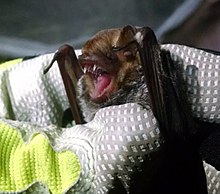Seminole bat
| Seminole bat | |
|---|---|

| |
| Scientific classification | |
| Domain: | Eukaryota |
| Kingdom: | Animalia |
| Phylum: | Chordata |
| Class: | Mammalia |
| Order: | Chiroptera |
| Family: | Vespertilionidae |
| Genus: | Lasiurus |
| Species: | L. seminolus
|
| Binomial name | |
| Lasiurus seminolus (Rhoads, 1895)
| |

| |
The Seminole bat (Lasiurus seminolus) is a species of bat in the family Vespertilionidae.
Taxonomy
| |||||||||||||||||||||||||||||||||||||||
| Relationship of L. seminolus within Lasiurus, based on an analysis of nuclear and mitochondrial DNA.[2] |
The Seminole bat was first
Description
The Seminole bat is often confused with the red bat. This is due to the coloring of the Seminole bat, which is a mahogany color with a frosted look due to white tipped dorsal hairs.[4] Coloring is not sexually dimorphic, meaning that males and females are similar in color.[4] Average weight is around 12 grams with females being larger than males.[4]
Diet
Seminole bats are insectivores. Insectivores are animals that feed primarily on insects. They have been found to eat relatively large amount of Hymenoptera (ants, bees and wasps), Coleoptera (beetles), Lepidoptera (moths).[5] They have also been shown to eat smaller amounts of Homoptera (cicadas) and Diptera (flies).[5]
Distribution
The Seminole bat is found in the
In 2015, it was documented for the first time in northwestern North Carolina.[7]
The bats prefer to live in forested areas. In winter months they are found to use

